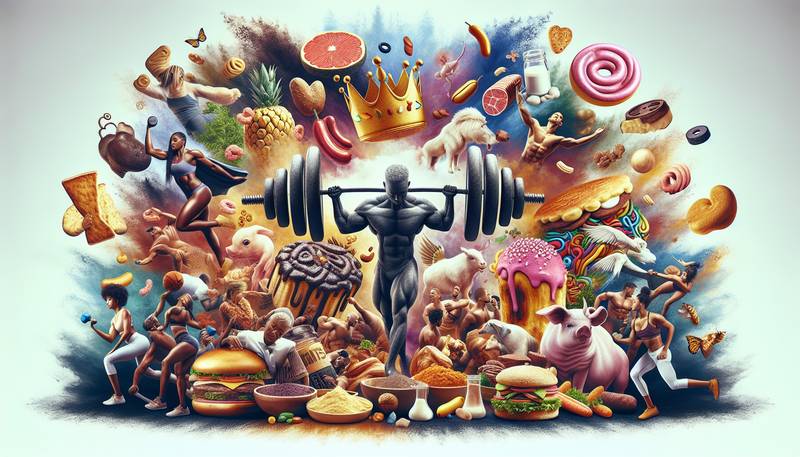Protein Consumption Trends: Balancing Nutritional Intake with Sodium, Saturated Fat, and Sugar

Protein: The Unsung Hero of Our PlatesProtein has somehow managed to be the reliable sidekick in our meals—the Robin to our Batman, if you will. While carbs and fats often steal the spotlight with their sultry allure, protein quietly holds everything together, reminding us that it’s the true MVP. Whether you're a gym enthusiast dreaming of bulging biceps or simply an ambitious pancake-flipper at brunch, protein is there, flexing just enough to get our attention without overshadowing the fluffy sweetness of our morning treat.Animal-based proteins have historically held the throne, ruling over our plates with sheer dominance. Think about it: steak still reigns supreme, while chicken is practically the go-to wingman for salads worldwide. But with the rise of plant-based diets, our protein preferences are branching out like an overzealous vine in a nature documentary.A Protein Revolution in the KitchenThe culinary landscape has experienced a seismic shift in recent years. Who would’ve thought that lentils and chickpeas would step into the limelight? If these legumes had a fan club, it would probably be packed, and everyone would be wearing matching green shirts. As people become increasingly health-conscious, there's been a noticeable uptick in demand for plant-based proteins. Consider the humble quinoa, once just a trendy word to impress your friends at brunch. Now it’s practically a household name, popping up everywhere, even in breakfast bars. However, it’s not just about swapping chicken for tofu. It’s about rethinking how we view protein sources. Before, it was like a one-act play, starring pork chops; now it's more akin to a full-blown musical featuring a diverse cast of legumes, nuts, and seeds, dancing their way into our meals.Navigating the Nutritional MinefieldWhile the protein shift is exciting, it’s essential to maintain balance. Yes, you’re packing in the protein, but what’s sneaking in with it? Sodium, saturated fat, and sugar have slyly crept into our diets, often hitching a ride with our favorite protein sources. Yes, that grilled chicken might be mouthwateringly delicious, but pair it with a heavy sauce, and suddenly you’re questioning your life choices.To keep your meals as healthy as a treadmill enthusiast, consider these factors when choosing your protein sources:- Sodium: The sneaky seasoning. Opt for fresh or low-sodium alternatives.
- Saturated Fat: It’s not just a word; it’s a lifestyle choice. Choose lean cuts or plant-based options.
- Sugar: When did protein bars start tasting like candy? Keep an eye out for added sugars in processed items.
Protein on the Go: A Balancing ActIn today’s hustle-and-bustle world, it’s easy to grab whatever protein source is within arm's reach. Enter: the protein shake brigade. They’re like little bottles of promises, but have you read the labels? Some of these blends could double as dessert, complete with sneaky sugars lurking in the ingredient list, asking, “Did you miss me?” As tempting as the pre-packed protein bars and shakes may be, consider this: a home-cooked meal can offer not just quality protein but also a side of pride in your culinary skills. After all, nothing says “health-conscious” quite like whipping up a delightful chickpea salad—or at least trying to, unless you’ve mastered the art of tossing the greens without a disaster.The Future of Protein: A Hybrid ApproachAs we stand on the precipice of change in dietary habits, the future of protein consumption looks like a blend—a hybrid approach that combines the best of both worlds. Animal proteins won’t disappear, but plant-based options will become staples, much like socks on laundry day. The key takeaway is about choices. The more protein sources available to us, the more our plates can reflect our values and health goals. It’s like being a kid in a candy store, except this candy is good for you, and you might actually finish it without ending up with a stomach ache.Embracing Balance in Protein ConsumptionFinding the right balance in protein consumption doesn’t have to feel like solving a Rubik’s Cube blindfolded. With a little attention to how much sodium, saturated fat, and sugar are tagging along for the ride, healthy eating can go from “meh” to magnificent! The road to optimal nutrition is paved with choices—some led by the hunky chicken breast, others by the bashful but mighty lentil. So go ahead, embrace the protein revolution, and let your meals reflect your taste buds and personal values. At the end of the day, just remember: it’s all about creating a plate that not only fills you up but leaves you smiling with every bite!
|
|







